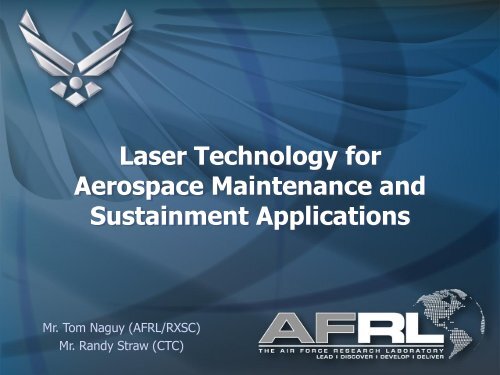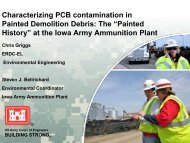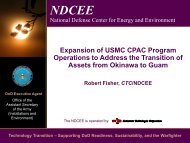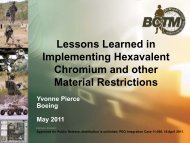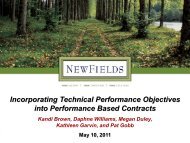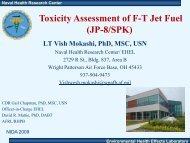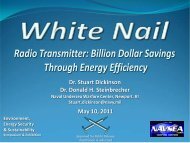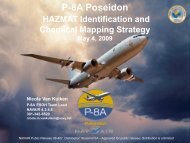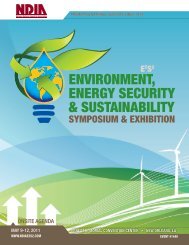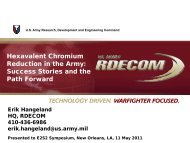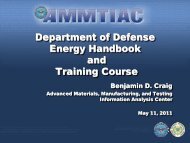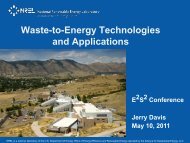10008 - E2S2
10008 - E2S2
10008 - E2S2
You also want an ePaper? Increase the reach of your titles
YUMPU automatically turns print PDFs into web optimized ePapers that Google loves.
Laser Technology for<br />
Aerospace Maintenance and<br />
Sustainment Applications<br />
Mr. Tom Naguy (AFRL/RXSC)<br />
Mr. Randy Straw (CTC)
2<br />
OVERVIEW<br />
• Problem Statement<br />
• Air Force Laser Program<br />
• Current Technologies<br />
• Future Robotic Technology<br />
• Advanced Laser Technology<br />
• Summary
3<br />
Problem Statement<br />
Current Coatings Removal Operations At ALCs<br />
Chemical Stripping<br />
Hand Sanding<br />
Plastic Media<br />
Blasting<br />
Water Pick<br />
Stripping is an expensive, time-consuming process that creates<br />
hazardous waste & emissions
4<br />
Air Force Laser Program<br />
AFRL and HQ AFMC exploring lasers for sustainment applications<br />
Program Goal:<br />
Establish and expand the use of laser technology as a viable<br />
alternative technology for depot maintenance operations<br />
Benefits:<br />
Environmentally Friendly<br />
No Damage to Substrate<br />
Reduce Flow Time<br />
Cost Effective<br />
Safety Compliant<br />
Increase Facility Capacity
5<br />
Current Technologies<br />
Handheld Laser Coatings Removal Systems<br />
Objective:<br />
• Evaluate ability of hand-held laser systems to<br />
supplement existing small-area depainting<br />
processes on components and aircraft at depot<br />
and field levels<br />
Benefits/Impacts:<br />
• Increase production rate<br />
• Replace Methylene Chloride, MEK, and PMB use<br />
– Reduce hazardous waste generation<br />
– Reduce handling and storage and worker exposure to known<br />
carcinogenic materials<br />
• Potential yearly reductions at OC-ALC (based on 5,040 parts for<br />
B-52) includes:<br />
– 2,500 gallons paint stripper<br />
– 32,630 pounds of hazardous waste<br />
– $99,140 at OC-ALC for nitpicking operations<br />
– $297,500 yearly at all 3 ALCs
Current Technologies<br />
Handheld Laser Coatings Removal Systems (cont.)<br />
• Evaluated 40, 120, and 500 W Nd:YAG and 250 W CO 2 handheld lasers<br />
• Results:<br />
– Adequate average removal rate for small area/nitpicking operations<br />
(≈14 in 2 /min)<br />
– No visual indication of surface damage<br />
– Measurements confirmed temperature spikes are not high enough to<br />
cause damage (
7<br />
Current Technologies<br />
Handheld Laser Coatings Removal Systems (cont.)<br />
• Laser technology is proving to be a viable alternative to present depainting<br />
operations as a supplemental approach<br />
– Results achieved during the laboratory testing were positive<br />
• Results are being utilized by other organizations to develop laser<br />
capabilities<br />
• Implementation of handheld laser technology into DoD<br />
– U.S. Air Force Depots<br />
• Oklahoma City Air Logistics Center (OC-ALC)<br />
• Ogden Air Logistics Center (OO-ALC)<br />
• Warner-Robins Air Logistics Center (WR-ALC)<br />
– U.S. Army (Ft. Rucker, AL)<br />
– U.S. Coast Guard Aviation Logistics Center (Elizabeth City, NC)<br />
• Air Force proceeded with robotic laser technology for large surface area<br />
applications based upon this successful program<br />
Handheld systems implemented and approved for use
8<br />
Current Technologies<br />
Robotic Laser Coating Removal System (RLCRS)<br />
Objective:<br />
• Develop robotic laser coating removal system<br />
to replace current chemical/ mechanical<br />
coating removal methods used on large offequipment<br />
components<br />
Benefits/Impacts:<br />
• Reduce stripping time and replace chemical<br />
strippers, MEK, PMB and wheat starch<br />
• Potential reductions at OC-ALC include:<br />
– 13,200 gallons paint stripper<br />
– 341,260 pounds of solid waste<br />
– 4003 pounds of VOCs<br />
– 1,815,000 gallons contaminated waste water<br />
– $390K savings in annual environmental costs
9<br />
Current Technologies<br />
RLCRS (cont.)<br />
• Design and construction of RLCRS was successful<br />
• Material testing demonstrated the safe use of RLCRS technology<br />
• System successfully transitioned into OC-ALC<br />
• Operators from all 3 shifts have been trained / used equipment at<br />
OC-ALC<br />
• Demonstrations have been conducted for E-3, B-1, and KC-135<br />
Engineering Offices<br />
• Approval for production usage has been granted by 2 of the 3 major<br />
weapon systems processed at OC-ALC<br />
• Based on positive results Ogden ALC commissioned the design and<br />
construction of a RLCRS<br />
• Interest from other facilities / services in acquiring robotic laser coating<br />
removal capabilities<br />
Cost Benefits Analysis Results<br />
$7.5 M Annual savings and<br />
10<br />
Current Technologies<br />
Advanced Robotic Laser Coating Removal System (ARLCRS)<br />
Objective:<br />
• Replace Laser Automated De-coating System<br />
(LADS) for OO-ALC<br />
• Integrate proven laser technology with a large robotic<br />
platform to create automated system for de-painting<br />
radomes and other off-aircraft components for both<br />
metal and composite substrates<br />
Requirements:<br />
• Ability to strip A-10, F-16 and C-130 radomes and<br />
off-aircraft parts<br />
• Requires turntable and robotic track system to<br />
access most part areas<br />
• Use commercially available and production proven<br />
laser components<br />
• Integrate contour following to maintain accurate<br />
stand-off and focal length<br />
• Perform stripping in +/- x direction
11<br />
Current Technologies<br />
ARCLRS (cont.)<br />
Benefits/Impacts:<br />
• Uses commercially available and production proven laser components<br />
• Able to strip A-10, F-16 and C-130 radomes and other off-aircraft parts<br />
– Multiple part geometries may be processed<br />
• Real-time contour following capability – no specific path programming required<br />
• Real-time surface temperature measurements<br />
• Smaller footprint<br />
• Faster strip rates<br />
– LADS took 4+ hours to strip F-16 radome and ARLCRS takes about 1/2 hour.<br />
• Cost savings of ~$330,000 annually for F-16 Radomes<br />
– Additional savings will be realized as system is used on other large off-aircraft parts<br />
LADS took 4+ hours to strip F-16 radome<br />
ARLCRS (LADS II) takes about ½ hour
12<br />
Current Technologies<br />
ARCLRS (cont.)<br />
LASER Comparison<br />
VS.<br />
LADS 6 kW LASER<br />
equipment<br />
filled a 16’x60’ room<br />
3’x 7’x 9’ LADS II<br />
8 kW COTS LASER<br />
made by Rofin Sinar
Current Technologies<br />
ARCLRS (cont.)<br />
LADS<br />
VS.<br />
LADS II<br />
• System successfully transitioned into OO-ALC<br />
• Currently in operation de-painting F-16<br />
radomes<br />
• Conducting test and evaluation with other<br />
weapons system program offices and<br />
engineering authorities to approve other<br />
components for this de-paint process<br />
– Working with A-10 and F-16 SPOs<br />
– Plan to work with F-22, B-2, and C-130<br />
Cost Savings<br />
$300,000 Annual Savings for F-16 radomes<br />
Increased capacity 80% - now able to process large off-aircraft parts<br />
13
14<br />
Future Robotic Technology<br />
Full Aircraft Coating Removal Systems<br />
Objective:<br />
• Develop, evaluate, and implement a state-of-the-art<br />
(SOTA) Advanced Robotic Laser Coatings Removal<br />
System (ARLCRS) for large on- and off-aircraft<br />
components and/or a full aircraft system<br />
• Two major components to make this successful<br />
– robotic system capable of handling a variety of components or<br />
aircraft<br />
– fiber laser optimized to provide increased production rate<br />
Benefits/Impacts:<br />
• Parts or aircraft stay in same position<br />
• Facility space could be used for other applications<br />
Status:<br />
• Several conceptual designs were developed and are<br />
under consideration for full aircraft applications<br />
• Targeted aircraft include F-16 and C-130<br />
• Hill AFB (OO-ALC) targeted installation facility
15<br />
Advanced Laser Technology<br />
• Evaluation of high power fiber laser is underway<br />
• Fiber delivered laser will allow for implementation in<br />
more advanced robotic designs<br />
– Fiber Laser Evaluation<br />
• Integrated 6 kW IPG fiber laser with Fanuc robot at<br />
CTC for additional testing & optimization<br />
• Tested both Visotek and ScanLab galvo based<br />
scanners<br />
– Scanlab scanner using optics that produce 1 mm<br />
x 5 mm elliptical spot size<br />
• Scanner pattern is a straight line that is 139 mm wide<br />
Robot Arm Sweep<br />
Direction<br />
Beam Scan Direction
16<br />
Advanced Laser Technology (cont.)<br />
• Fiber laser now being tested on various substrate / coating<br />
combinations<br />
– 4 cycles of coating/laser stripping of chromated 2024 and 7075 aluminum<br />
substrates coated with a 10 mil standard MIL-PRF-23377 primer and MIL-<br />
PRF-85285 topcoat completed December 09<br />
• Temperature: Max temp
17<br />
Advanced Laser Technology (cont.)<br />
• Based on positive results on standard aluminum and coating system<br />
fiber laser will be tested on weapon system specific systems.<br />
• Substrates<br />
Substrate Description<br />
Aluminum alloy: 2024-T3<br />
Cleaning: ASTM F22-65 (or FED Spec TT-C-490-E)<br />
Surface Treatment: Sulfuric acid anodized (MIL-A-8625, Class 1, Type 2)<br />
Panel<br />
Size<br />
(inches)<br />
Panel<br />
Thickness<br />
(inches or<br />
plies)<br />
Associated<br />
Aircraft<br />
24”x18” 0.025” F-16<br />
Aluminum alloy: 2024-T3<br />
Cleaning: ASTM F22-65 (or FED Spec TT-C-490-E)<br />
Surface Treatment: PreKote<br />
Aluminum Honeycomb<br />
Face Sheets: 0.010” thick 2024-T3 clad aluminum<br />
Core: 0.625” thick aluminum core, Hexagonal, non-perforated 3/16” cell, 0.0020” nominal foil, Al<br />
alloy 3003-H18 or H19 (Optional 5052-H38 or H-39).<br />
Aluminum Honeycomb<br />
Face Sheets: 0.016” 2024-T3 clad aluminum<br />
Core: Same as above<br />
Aluminum Honeycomb<br />
Face Sheets: 0.020” 2024-T3 clad aluminum<br />
Core: Same as above<br />
24”x18” 0.025” F-16<br />
24”x18” 0.010”<br />
(Face sheet<br />
thickness)<br />
24”x18” 0.016”<br />
(Face sheet<br />
thickness)<br />
24”x18” 0.020”<br />
(Face sheet<br />
thickness)<br />
F-16, C-130<br />
F-16, C-130<br />
F-16, C-130
18<br />
Advanced Laser Technology (cont.)<br />
• Coating Systems to be tested<br />
Primer<br />
Topcoat<br />
Primer<br />
Mid-Coat<br />
Primer<br />
Topcoat<br />
Coating Specification 1 Thickness (mils)<br />
MIL-PRF-23377,<br />
Type 1, Class C2<br />
MIL-PRF-85285,<br />
Type 1, Class H,<br />
APC<br />
MIL-PRF-23377,<br />
Type 1, Class C2<br />
A-A-59166, Type 2,<br />
Non-skid walkway<br />
coating<br />
MIL-PRF-23377,<br />
Type 1, Class C2<br />
MIL-PRF-85285,<br />
Type 1, Class H<br />
0.6 – 0.9<br />
9<br />
0.6 – 0.9<br />
Manufacturer<br />
(Part Number)<br />
Sherwin Williams (SW)<br />
(E90G203/V93V230) or PPG<br />
(EEAY051A)<br />
Deft Extended Life (99GY001)<br />
or PPG (CA9311/F36173)<br />
SW (E90G203/V93V230) or<br />
PPG (EEAY051A)<br />
Color<br />
Yellow<br />
Gray<br />
Yellow<br />
30-50 Hentzen (8010-00-641-0426) N/A<br />
0.6 – 0.9<br />
9<br />
SW (E90G203/V93V230) or<br />
PPG (EEAY051A)<br />
Deft Extended Life (99GY001)<br />
or PPG (CA9311/F36173)<br />
Yellow<br />
Gray<br />
Aircraft<br />
F-16,<br />
C-130<br />
C-130
19<br />
Advanced Laser Technology (cont.)<br />
• Panels are now being prepared and 4 cycle coating/stripping is<br />
underway<br />
• At the completion of the 4 cycle stripping mechanical testing will be<br />
performed<br />
• Aluminum Substrate: Strip Rate, Visual Assessment, Substrate<br />
Temperature, Electrical Conductivity, Rockwell Hardness, Tensile,<br />
Smooth and Notched Fatigue<br />
• Metallic Honeycomb: Strip Rate, Visual Assessment, Substrate<br />
Temperature, Coin Tap, Peel Resistance, Flat-wise Tensile<br />
• Final test results will be available in Summer 2010
20<br />
Summary<br />
‣ Laser technology is proven and in use<br />
• DoD laser coating removal efforts have positively demonstrated<br />
technology (i.e., RLCRS at OC-ALC and LADS II at OO-ALC)<br />
‣ Results achieved during laboratory testing and system<br />
transition activities are positive<br />
‣ Work is moving towards full aircraft coatings removal and<br />
specialty coatings removal applications
21<br />
Contact Info<br />
Environmental and Energy Quality Team<br />
Mr. Tom Naguy (AFRL/RXSC)<br />
Mr. Randy Straw (CTC)<br />
Concurrent Technologies Corporation<br />
thomas.naguy@wpafb.af.mil<br />
(937) 656-5709<br />
randall.straw@wpafb.af.mil<br />
(937) 255-5598<br />
Mr. Gerard Mongelli<br />
Mr. Jim Arthur<br />
mongellg@ctc.com<br />
(937) 306-3310<br />
arthurj@ctc.com<br />
(412) 992-5362


